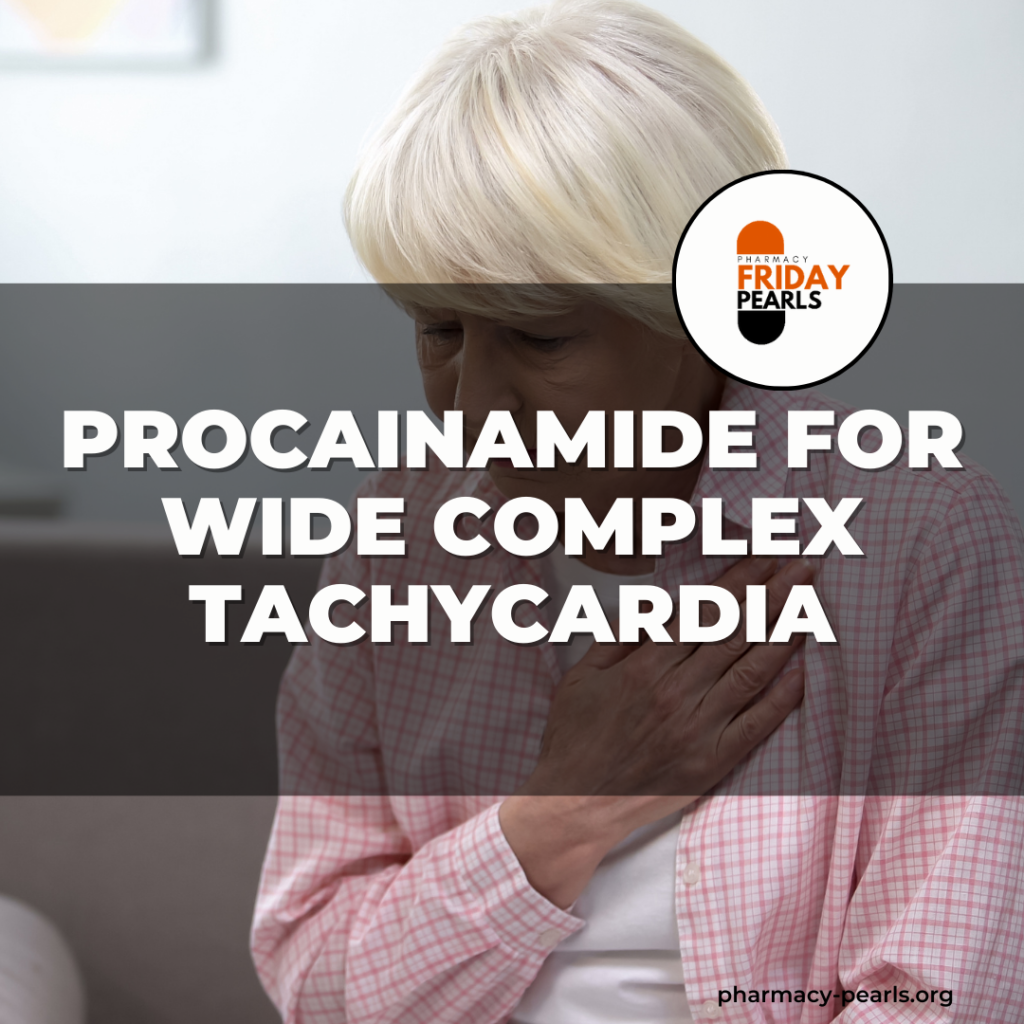Procainamide for Wide Complex Tachycardia
Procainamide for Wide Complex Tachycardia
Pharmacy Friday Pearl – Pharmacy & Acute Care University
Download PDFIntroduction
- Ventricular tachycardia (VT) is an uncommon but dangerous medical condition with an extremely variable clinical presentation.
- Intravenous procainamide is guideline recommended and is the drug of choice for hemodynamically stable VT with a class IIa recommendation.
- Procainamide is an old drug with new evidence supporting its use, but dosing strategies and administration techniques make it difficult to use at the bedside.
Procainamide
| Parameter | Details |
|---|---|
| Bolus Dose | 10–17 mg/kg over 20–60 minutes (Max dose 1g, max rate 20–50 mg/min) OR 100 mg every 5 minutes (max rate 50 mg/min) up to 1g |
| Renal Adjustments | eCrCl 10–50 ml/min: reduce dose by 25–50% eCrCl <10 ml/min: reduce dose by 50–75% |
| Maintenance Infusion | 1–6 mg/min |
| Mechanism | Class 1A anti-arrhythmic; blocks fast sodium channels, prolongs action potential, reduces impulse conduction speed |
| PK/PD | IV Onset: <2 min; IM: 10–30 min IV Peak: 25–60 min; IM: 15–60 min Duration: 3–4 hrs Metabolism: Hepatic to active NAPA Half-life: 2.5–4.7 hrs (NAPA: 7 hrs) Excretion: 40–70% renally unchanged |
| Adverse Effects | Hypotension, hepatotoxicity, lupus-like syndrome, positive ANA, anaphylaxis (sulfite), MG exacerbation, angioedema |
| Drug Interactions | Interacts with diazepam, diltiazem, milrinone, phenytoin, hydralazine |
| Compatibility | Compatible: 0.9% NaCl, 0.45% NaCl Incompatible: D5 (variable), LR, D5NS |
Clinical Pearl: Define institutional dosing and administration policies due to variable strategies in the literature and risk of adverse events.
Overview of Key Evidence
| Author/Year | Design (n) | Key Findings |
|---|---|---|
| Ortiz, 2017 | RCT (n=62) | Procainamide: 67% VT termination; 9% major cardiac adverse Amiodarone: 38% VT termination; 41% adverse |
| Marill, 2010 | Multicenter cohort (n=187) | VT termination: Amio 25%, Procainamide 30% |
| Komura, 2010 | Retrospective (n=90) | Procainamide terminated 75.7% VT vs. Lidocaine 35% |
| Marill, 2006 | Case series (n=33) | Amio VT termination: 29%; 6% needed cardioversion |
| Gorgels, 1996 | Randomized (n=79) | Procainamide terminated 79% VT vs. Lidocaine 19% (p<0.001) |
| Callans, 1992 | Observational (n=15) | VT termination rate 93% with median 600 mg procainamide |
Clinical Conclusions
- Procainamide is guideline-supported for stable VT (Class IIa).
- Use empiric 10–17 mg/kg bolus dosing up to 1g.
- Consider renal function for bolus dose reductions.
- Initiate maintenance infusion at 1–6 mg/min after bolus.
- Clearly define hospital protocols to avoid variability.
Full Reference List
- Procainamide. Micromedex [Electronic version]. Greenwood Village, CO: Truven Health Analytics. Retrieved July 6, 2020, from http://www.micromedexsolutions.com/
- Long B, Koyfman A. Best Clinical Practice: Emergency Medicine Management of Stable Monomorphic Ventricular Tachycardia. J Emerg Med. 2017;52:484-492.
- Ortiz M, Martín A, Arribas F, et al. Randomized comparison of intravenous procainamide vs. intravenous amiodarone for the acute treatment of tolerated wide QRS tachycardia: the PROCAMIO study. Eur Heart J. 2017;38(17):1329-1335.
- Marill KA, deSouza IS, Nishijima DK, et al. Amiodarone or procainamide for the termination of sustained stable ventricular tachycardia: an historical multicenter comparison. Acad Emerg Med. 2010;17(3):297-306.
- Komura S, Chinushi M, Furushima H, et al. Efficacy of procainamide and lidocaine in terminating sustained monomorphic ventricular tachycardia. Circ J. 2010;74(5):864-869.
- Marill KA, deSouza IS, Nishijima DK, et al. Amiodarone is poorly effective for the acute termination of ventricular tachycardia. Ann Emerg Med. 2006;47(3):217-224.
- Gorgels AP, van den Dool A, Hofs A, et al. Comparison of procainamide and lidocaine in terminating sustained monomorphic ventricular tachycardia. Am J Cardiol. 1996;78(1):43-46.
- Callans DJ, Marchlinski FE. Dissociation of termination and prevention of inducibility of sustained ventricular tachycardia with infusion of procainamide: evidence for distinct mechanisms. J Am Coll Cardiol. 1992;19(1):111-117.
- Wellens HJ, Bär FW, Lie KI, et al. Effect of procainamide, propranolol and verapamil on mechanism of tachycardia in patients with chronic recurrent ventricular tachycardia. Am J Cardiol. 1977;40(4):579-585.


Responses